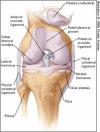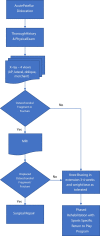Non-operative Management of Acute Knee Injuries
- PMID: 38095838
- PMCID: PMC10767052
- DOI: 10.1007/s12178-023-09875-7
Non-operative Management of Acute Knee Injuries
Abstract
Purpose of review: Acute knee injuries are commonly encountered in both the clinical and sideline setting and may be treated operatively or non-operatively. This article describes an evidence-based approach to non-operative acute knee injury. This includes history, physical exam, imaging, and initial management. In addition, the non-operative management of three such injuries-ligament injury, meniscus injury, and patellar dislocation injury-will be discussed via a case-based practical approach.
Recent findings: Aside from grade III ACL tears, most acute knee ligament injuries, especially in the absence of other concurrent injuries, can be treated non-operatively. There is new evidence that acute traumatic meniscus tears in those younger than 40 can be successfully treated non-operatively and can do equally, as well as those that undergo surgery, at 1 year out from injury. Based on the current literature, a short period of knee bracing in extension with progression to weightbearing to tolerance is recommended after initial patellar dislocation. Many of the most common acute knee injuries, including MCL tears, meniscus tears, and patellar dislocations, can be managed non-operatively. A detailed systemic approach to initial evaluation, including pertinent history, physical exam, and appropriate imaging, is essential and complementary to the subsequent non-operative treatment algorithm.
Keywords: Ligamentous knee injury (ACL, MCL, PCL, LCL); Meniscus tear; Patellar instability; Rehabilitation.
© 2023. The Author(s), under exclusive licence to Springer Science+Business Media, LLC, part of Springer Nature.
Conflict of interest statement
Shaheen Jadidi declares that he has no conflict of interest.
Aaron Lee declares that he has no conflict of interest.
Eliza Pierko declares that he has no conflict of interest.
Haemi Choi declares that he has no conflict of interest.
Nathaniel S. Jones declares that he has no conflict of interest.
Figures
References
-
- Gage BE, et al. Epidemiology of 6.6 million knee injuries presenting to United States emergency departments from 1999 through 2008. Acad Emerg Med. 2012;19(4):378–85. - PubMed
-
- Caine D, Maffulli N, Caine C. Epidemiology of injury in child and adolescent sports: injury rates, risk factors, and prevention. Clin Sports Med. 2008;27(1):19–50, vii. - PubMed
-
- Bunt CW, Jonas CE, Chang JG. Knee pain in adults and adolescents: the initial evaluation. Am Fam Physician. 2018;98(9):576–585. - PubMed
Publication types
LinkOut - more resources
Full Text Sources
Research Materials





